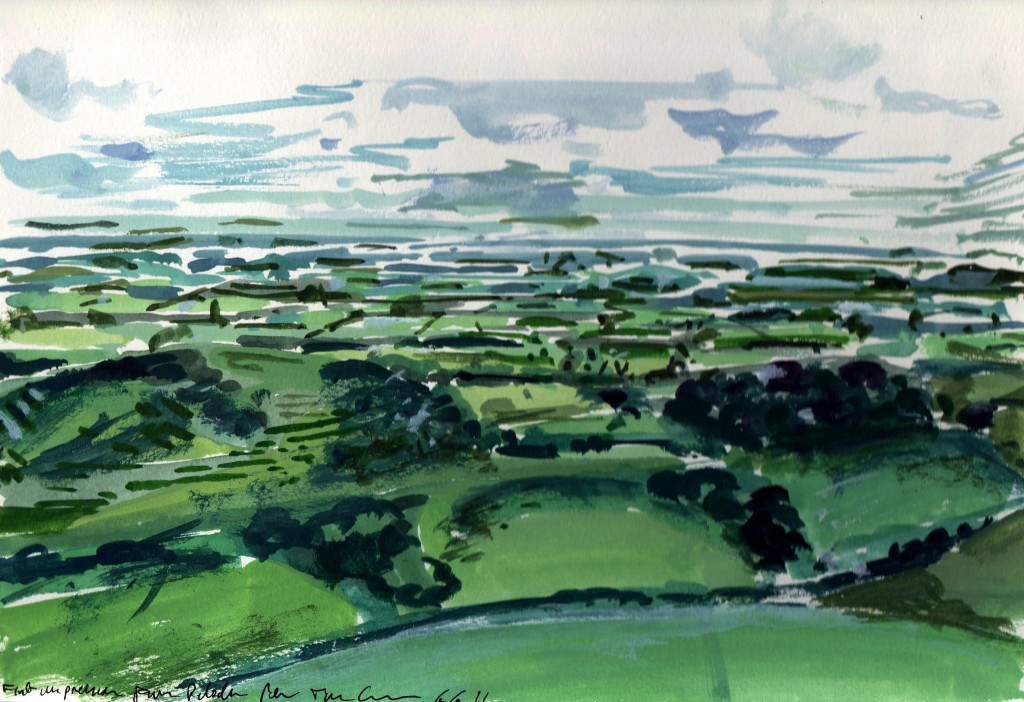The four landscape paintings on exhibition at The Rowley Gallery were committed to 200gsm acid-free paper using artist’s watercolours and gouache from the peaks of Eggardon Hill and Pilsdon Pen in north west Dorset. Pilsdon is Dorset’s highest hill, and closely associated with the legend of the screaming skull at Bettiscombe Manor, down there in the Marshwood Vale. For many years the skull in question was believed to be that of an African servant girl of the 18th century. Under recent analysis it was proved to be the skull of a young girl of the late Neolithic, circa 4,000 BC. This is close to the vintage of the ancient shaped hills and sacred landscapes of Dorset – stone circles, burrows, tumps, burial sites, excarnation sites, and later fashioned as fortresses raised against the worsening weather and tribal pomp of the Iron Age. All are studded with human, animal and ritual remains in their steep, deeply dug chalk banks.
These four paintings were made within the space of a week, field paintings drawn directly from the landscape, from long exposure, a sort of contact sheet pressed through the Moleskine watercolour paper. The wind and the light is in the paint. On clear days you can see all the way to the Devon coastline, and right down to the coast beyond West Bay, the pebble beach, the schools of mackerel near the shore at dawn, the strong currents and heavy tides of a difficult sea. And below us is Marshwood Vale – all those green and silver flashes. Back in 17th century Serbia, the incoming Hapsburg empire passed a law of the land insisting, on pain of imprisonment, that all the religious painters, the icon makers of the Orthodox monasteries hidden among heavily wooded hills north of Novi Sad, between the Danube and the Balaton, follow the laws of perspective instead of the traditions of Byzantium. They did, but with a vengeance. You’ve never seen such contorted viewpoints. The laws of perspective were used as political weapons, and that view of perspective fascinates me. Especially as it applies to two-dimensional surfaces.
From Eggardon or Pilsdon Pen the perspectives are uniform and sheer. All is distance. And yet that band of light over the fastness of the sea is both very far away and as close as a lover’s touch. These are paintings made to travel through, images made to evoke sensation more than recognition. And so I leave you with a poem of sensation to accompany the paintings, for there, down in the Marshwood Vale, a few miles south west of Pilsdon Pen, is a handsome Georgian farmhouse called Racedown, which is where Coleridge and Wordsworth first met in the last years of the 18th century. Coleridge had walked from Somerset and came bounding to meet the Wordsworths over a field of corn. It is an image that, for me, does not fade.
I wrote the poem while reading the first of Richard Holmes’s two volume biography of Coleridge, and it was in my bag as I made these paintings. I’d had to put it down for a while, dreading the long, steep decline in the poet’s fortunes to come. The aurochs mentioned are Dorset Longhorns, bred back from the past by a Falklands veteran near the village of Little Bredy, where Evelyn Waugh’s Brideshead Revisited originated, and where beautiful, stippled trout hang near the surface of the clear lake fed by a spring, the source of the river Bride (Bredy is an old word for bright, burning water) in the grounds of the old manor house.
RACEDOWN
Racedown from Pilsdon Pen
into Marshwood Vale, the river bank’s
calligraphic flourish through grassy birdlands
and there at the gate where Samuel spied
William and Dorothy at work in their garden
laying down the line
and both remember him crashing towards them
some 40 years on, advancing heavily into the corn
like a sacrificial victim, mouth on fire with realised
dreams before the ancient mariner of nightmares
and long winter.
And here we come leaping
over the stile, through the young green corn
and wild hedgerow honeysuckle, orchids in a meadow
by the gate from the road and the wild secret world
of Dorset aurochs stirring from the wall, shrugging off
the isobars of warmth and glaciation, sliding their weight
between them, beasts of monumental grasses you could
cast like milky brasses
as we come bounding by,
down the folds and thighs of the valleylands
around Racedown, strangers at the stile.
Tell them we are coming.
Tell them we have not grown old.
Tim Cumming / The Rowley Gallery






